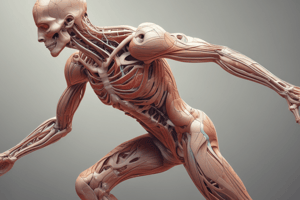Podcast
Questions and Answers
¿Qué tipo de articulación es la coxofemoral?
¿Qué tipo de articulación es la coxofemoral?
- Enartrosis (correct)
- Trocoide
- Troclear
- Condílea
¿Cuál es el ángulo de recubrimiento de la cabeza femoral en el acetábulo?
¿Cuál es el ángulo de recubrimiento de la cabeza femoral en el acetábulo?
- 45°
- 30° (correct)
- 60°
- 90°
¿Hacia dónde está dispuesto oblicuamente el cuello del fémur y la cabeza?
¿Hacia dónde está dispuesto oblicuamente el cuello del fémur y la cabeza?
- Abajo, dentro y atrás
- Arriba, fuera y adelante
- Abajo, fuera y atrás
- Arriba, dentro y adelante (correct)
¿Cuál es el ángulo de inclinación de la cabeza femoral?
¿Cuál es el ángulo de inclinación de la cabeza femoral?
¿Cuál es el ángulo de anteversión en la articulación coxofemoral?
¿Cuál es el ángulo de anteversión en la articulación coxofemoral?
¿Qué tipo de pelvis es buena para estabilizar y fuerza?
¿Qué tipo de pelvis es buena para estabilizar y fuerza?
¿Qué es la cápsula en la articulación coxofemoral?
¿Qué es la cápsula en la articulación coxofemoral?
¿En qué posición se tensan los ligamentos coxofemorales?
¿En qué posición se tensan los ligamentos coxofemorales?
¿Qué función biomecánica tiene el ligamento redondo?
¿Qué función biomecánica tiene el ligamento redondo?
¿En qué posición se considera que la cadera está en bloqueo?
¿En qué posición se considera que la cadera está en bloqueo?
¿Cuáles son los movimientos de la articulación coxofemoral?
¿Cuáles son los movimientos de la articulación coxofemoral?
¿Qué sucede con el ángulo de anteversión en bipedestación?
¿Qué sucede con el ángulo de anteversión en bipedestación?
¿Qué tipo de articulación es la coxofemoral?
¿Qué tipo de articulación es la coxofemoral?
¿Cuál es el ángulo de recubrimiento de la articulación coxofemoral?
¿Cuál es el ángulo de recubrimiento de la articulación coxofemoral?
¿Hacia dónde está dispuesto oblicuo el cuello del fémur?
¿Hacia dónde está dispuesto oblicuo el cuello del fémur?
¿Cuál es el ángulo de inclinación de la cabeza femoral?
¿Cuál es el ángulo de inclinación de la cabeza femoral?
¿Cuál es el ángulo de anteversión de la articulación coxofemoral?
¿Cuál es el ángulo de anteversión de la articulación coxofemoral?
¿Qué tipo de pelvis es buena para estabilizar y fuerza?
¿Qué tipo de pelvis es buena para estabilizar y fuerza?
¿Qué es la cápsula en la articulación coxofemoral?
¿Qué es la cápsula en la articulación coxofemoral?
¿Cuándo se tensan los ligamentos coxofemorales?
¿Cuándo se tensan los ligamentos coxofemorales?
¿Qué función biomecánica tiene el ligamento redondo en la articulación coxofemoral?
¿Qué función biomecánica tiene el ligamento redondo en la articulación coxofemoral?
¿Qué es la posición de bloqueo en la articulación coxofemoral?
¿Qué es la posición de bloqueo en la articulación coxofemoral?
¿Cuáles son los movimientos de la articulación coxofemoral?
¿Cuáles son los movimientos de la articulación coxofemoral?
Flashcards
What type of joint is the hip joint?
What type of joint is the hip joint?
A ball-and-socket joint, where the head of the femur fits into the acetabulum of the pelvis.
What is the angle of inclination of the femoral head?
What is the angle of inclination of the femoral head?
The angle formed by the head of the femur and the neck of the femur.
What is the angle of anteversion of the hip joint?
What is the angle of anteversion of the hip joint?
The angle formed between the neck of the femur and the shaft of the femur.
What is the angle of coverage of the hip joint?
What is the angle of coverage of the hip joint?
Signup and view all the flashcards
What is the hip joint capsule?
What is the hip joint capsule?
Signup and view all the flashcards
What position causes tension in the hip ligaments?
What position causes tension in the hip ligaments?
Signup and view all the flashcards
What is the hip's 'locked' position?
What is the hip's 'locked' position?
Signup and view all the flashcards
What are the movements of the hip joint?
What are the movements of the hip joint?
Signup and view all the flashcards
What type of pelvis is good for stability and strength?
What type of pelvis is good for stability and strength?
Signup and view all the flashcards
What is the function of the ligamentum teres in the hip joint?
What is the function of the ligamentum teres in the hip joint?
Signup and view all the flashcards
What happens to the angle of anteversion in standing?
What happens to the angle of anteversion in standing?
Signup and view all the flashcards
In what direction is the neck of the femur?
In what direction is the neck of the femur?
Signup and view all the flashcards
Is the hip joint covered by a fibrous capsule?
Is the hip joint covered by a fibrous capsule?
Signup and view all the flashcards
What is the angle of inclination of the femoral head?
What is the angle of inclination of the femoral head?
Signup and view all the flashcards
What is the angle of anteversion of the hip joint?
What is the angle of anteversion of the hip joint?
Signup and view all the flashcards
What type of joint is the hip joint?
What type of joint is the hip joint?
Signup and view all the flashcards
What does the angle of coverage of the femoral head provide?
What does the angle of coverage of the femoral head provide?
Signup and view all the flashcards
What is the function of the hip joint?
What is the function of the hip joint?
Signup and view all the flashcards
What is the orientation of the head and neck of the femur?
What is the orientation of the head and neck of the femur?
Signup and view all the flashcards
What is the function of the ligamentum teres?
What is the function of the ligamentum teres?
Signup and view all the flashcards
What is the function of the pelvis?
What is the function of the pelvis?
Signup and view all the flashcards
What is the hip's position of maximum stability?
What is the hip's position of maximum stability?
Signup and view all the flashcards
Study Notes
Anatomía y biomecánica de la articulación coxofemoral
- La articulación coxofemoral es una enartrosis compuesta por la cabeza del fémur y el acetábulo de la cadera.
- El ángulo de recubrimiento o de "Wiberg" es de aproximadamente 30° y junto al ángulo de anteversión da condiciones para una buena biomecánica.
- El cuello del fémur está dispuesto oblicuo hacia arriba, hacia dentro y hacia adelante, al igual que la cabeza.
- El ángulo de inclinación de la cabeza femoral es de aproximadamente 125° y si varía excesivamente puede provocar patología.
- El ángulo de anteversión es de unos 15º - 20º, pero en bipedestación se reduce.
- La pelvis brevilínea tiene ángulos menores y es buena para estabilizar y fuerza, mientras que la pelvis longilínea tiene ángulos mayores y es buena para correr.
- Existe un eje mecánico que hace que a lo largo de los movimientos, la musculatura actúe de una u otra manera.
- La cápsula es un manguito fibroso que recubre del reborde cotiloideo a la línea intertrocantérea en el cuello del fémur.
- Los ligamentos coxofemorales se tensan en la extensión y se distienden en flexión.
- El ligamento redondo no tiene función biomecánica pero tiene un importante aporte vascular.
- La cadera en posición de bloqueo es aquella con la cadera en extensión, ligera rotación interna y ABD.
- Los movimientos de la articulación coxofemoral incluyen extensión, flexión, abducción, aducción, rotación interna y rotación externa.
Studying That Suits You
Use AI to generate personalized quizzes and flashcards to suit your learning preferences.
Description
¿Te gustaría poner a prueba tus conocimientos en anatomía y biomecánica de la articulación coxofemoral? ¡Este quiz es para ti! Descubre cuánto sabes sobre la estructura, ángulos, movimientos y ligamentos de esta importante articulación del cuerpo humano. Aprende sobre la pelvis brevilínea y longilínea, el ángulo de anteversión y el ligamento redondo. ¡





